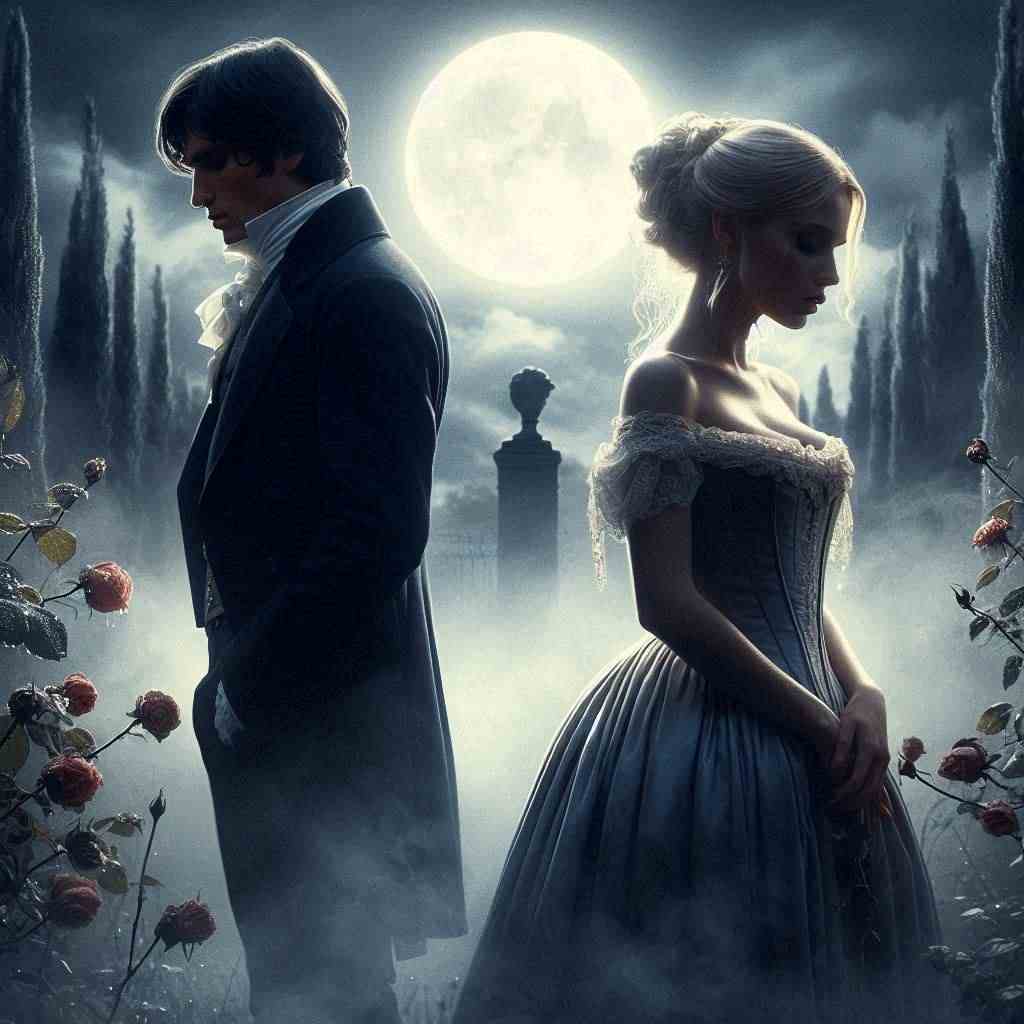When We Two Parted
Lord Byron
1788 to 1824

When we two parted
In silence and tears,
Half broken-hearted
To sever for years,
Pale grew thy cheek and cold,
Colder thy kiss;
Truly that hour foretold
Sorrow to this.
The dew of the morning
Sunk chill on my brow—
It felt like the warning
Of what I feel now.
Thy vows are all broken,
And light is thy fame;
I hear thy name spoken,
And share in its shame.
They name thee before me,
A knell to mine ear;
A shudder comes o’er me—
Why wert thou so dear?
They know not I knew thee,
Who knew thee too well—
Long, long shall I rue thee,
Too deeply to tell.
In secret we met—
In silence I grieve,
That thy heart could forget,
Thy spirit deceive.
If I should meet thee
After long years,
How should I greet thee?—
With silence and tears.
Lord Byron's When We Two Parted
Introduction
Lord Byron's "When We Two Parted" stands as a poignant exploration of lost love, secrecy, and emotional devastation. This lyrical poem, composed in 1808 but not published until 1813, exemplifies the Romantic era's preoccupation with intense personal emotions and the bittersweet nature of human relationships. Byron's mastery of form and language creates a haunting portrait of a clandestine affair's aftermath, resonating with readers across generations. This analysis will delve into the poem's structure, thematic content, and literary devices to uncover the layers of meaning within Byron's carefully crafted verses.
Structure and Form
The poem consists of four octaves, each following a consistent rhyme scheme of ABABCDCD. This structure, reminiscent of the ballad form, lends itself to the narrative quality of the piece while maintaining a musical cadence that echoes the emotional rhythms of the speaker's lament. The alternating iambic tetrameter and trimeter lines create a lilting, almost faltering effect, mirroring the unsteady emotional state of the narrator.
Byron's choice of short lines and stanzas contributes to the poem's sense of fragmentation and loss. Each stanza encapsulates a distinct emotional moment or reflection, building upon the previous one to create a cumulative effect of grief and regret. The brevity of the lines also serves to intensify the emotional impact, with each word carrying significant weight in the overall composition.
Thematic Analysis
At its core, "When We Two Parted" is an elegy for a doomed love affair. The poem's central themes revolve around secrecy, shame, and the lingering pain of separation. Byron masterfully weaves these elements together to create a tapestry of complex emotions that transcend the specific circumstances of the relationship.
The theme of secrecy is introduced in the very first stanza with the line "In silence and tears," setting the tone for the clandestine nature of the affair. This secrecy is further emphasized in the third stanza with "They know not I knew thee, / Who knew thee too well," highlighting the disconnect between public perception and private reality. The secret nature of their relationship adds a layer of complexity to the speaker's grief, as they must bear their pain in isolation.
Shame emerges as another prominent theme, closely tied to the affair's secretive nature. The lines "I hear thy name spoken, / And share in its shame" reveal that the former lover's reputation has been tarnished, and the speaker, despite their separation, still feels connected to this disgrace. This shared shame underscores the lasting impact of their relationship and the social consequences of their actions.
The poem's overarching theme of emotional devastation is evident throughout, but it reaches its zenith in the final stanza. The speaker's imagined future encounter with their former lover, marked by "silence and tears," mirrors the opening of the poem, creating a cyclical structure that suggests the inescapability of their grief.
Literary Devices and Imagery
Byron employs a rich array of literary devices to enhance the emotional resonance of "When We Two Parted." The use of alliteration in phrases like "sorrow to this" and "long, long shall I rue thee" creates a sonic texture that reinforces the poem's melancholic tone. The repetition of "silence and tears" at the beginning and end of the poem serves as a powerful framing device, emphasizing the unchanging nature of the speaker's pain.
Imagery plays a crucial role in conveying the emotional landscape of the poem. The physical descriptions in the first stanza, "Pale grew thy cheek and cold, / Colder thy kiss," use temperature as a metaphor for the cooling of affection and the onset of emotional distance. This imagery is echoed in the second stanza with "The dew of the morning / Sunk chill on my brow," extending the sensation of coldness to the natural world and foreshadowing the emotional chill that would follow.
The auditory imagery of "A knell to mine ear" when hearing the former lover's name spoken adds a funereal tone to the poem, suggesting that the relationship's end is akin to a death. This morbid undertone is further reinforced by the visceral reaction described in "A shudder comes o'er me," illustrating the physical manifestation of emotional trauma.
Narrative Voice and Tone
The poem's first-person narrative allows for an intimate exploration of the speaker's emotions. The use of archaic pronouns like "thee" and "thy" adds a sense of formality and distance, potentially reflecting the emotional gulf that has grown between the former lovers. This linguistic choice also serves to elevate the poem's tone, giving it a timeless quality that transcends its specific historical context.
The tone of "When We Two Parted" is predominantly one of melancholy and regret. However, there are subtle shifts throughout the poem that reveal the complexity of the speaker's emotional state. The initial sadness gives way to a sense of betrayal and bitterness in lines like "Thy vows are all broken, / And light is thy fame." This evolution of emotion culminates in the final stanza's mixture of longing and resignation, as the speaker contemplates a future encounter with a mixture of desire and dread.
Contextual Considerations
While "When We Two Parted" can be appreciated as a universal exploration of lost love, it is important to consider the biographical and historical context of its creation. Byron's tumultuous personal life and numerous affairs often informed his poetry, and this piece is thought to have been inspired by his relationship with Lady Frances Webster. The poem's themes of secrecy and shame take on added significance when viewed through the lens of 19th-century social mores and the potential scandals associated with extramarital affairs among the aristocracy.
Furthermore, the poem's publication during the Romantic era places it within a literary movement that valued emotional authenticity and individual experience. Byron's unflinching examination of personal pain aligns with the Romantic ideal of the poet as a figure who feels deeply and translates those feelings into art.
Conclusion
"When We Two Parted" stands as a testament to Lord Byron's poetic prowess and his ability to distill complex emotions into crystalline verse. Through its careful structure, evocative imagery, and nuanced exploration of theme, the poem creates a powerful meditation on the aftermath of a failed relationship. The universality of its emotional core ensures its continued relevance, while its craft and artistry secure its place in the canon of English literature.
Byron's masterful use of form and language creates a work that is at once deeply personal and broadly relatable. The poem's exploration of secrecy, shame, and enduring emotional pain speaks to the human experience of love and loss in a way that transcends its specific historical moment. As readers, we are invited to share in the speaker's grief, to feel the chill of that morning dew, and to contemplate our own experiences of parting and regret.
In the end, "When We Two Parted" reminds us of poetry's power to articulate the ineffable aspects of human emotion. It stands as a poignant reminder of the lasting impact of our relationships and the complex interplay between personal experience and social expectations. Byron's enduring legacy is evident in works like this, which continue to move and inspire readers with their emotional honesty and artistic brilliance.
This text was generated by AI and is for reference only. Learn more
Want to join the discussion? Reopen or create a unique username to comment. No personal details required!



Comments
No comments yet. Be the first to comment!